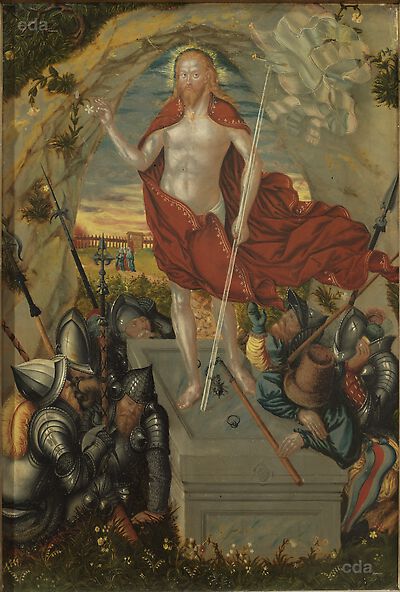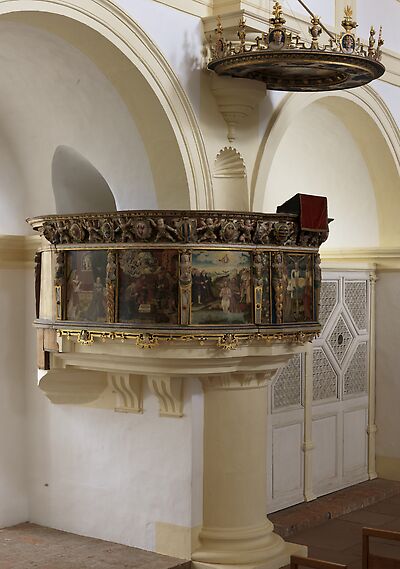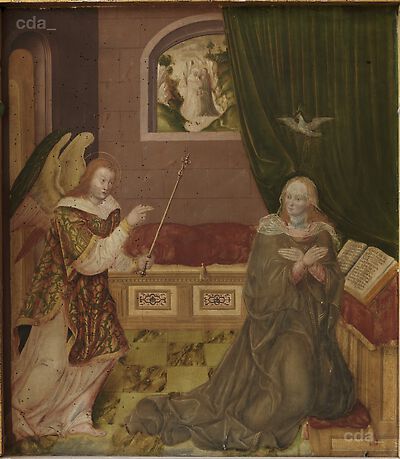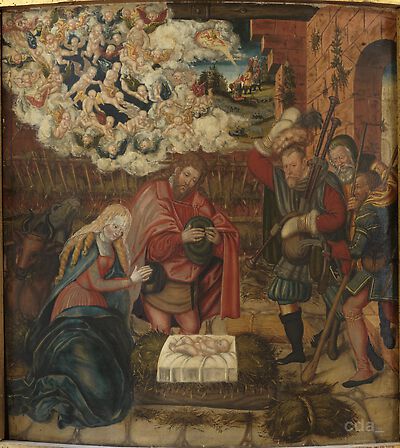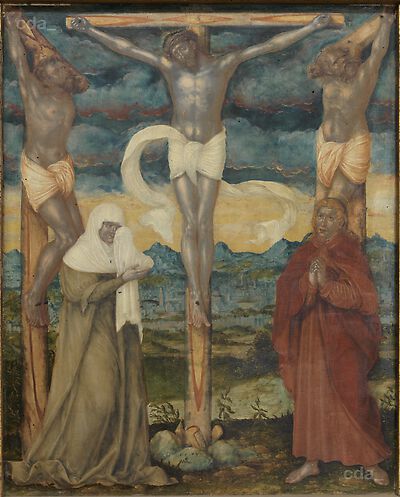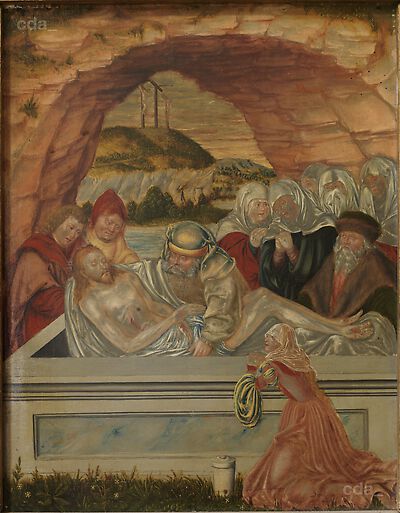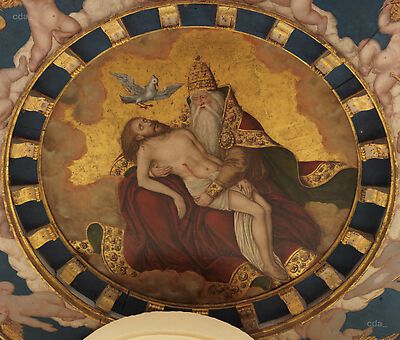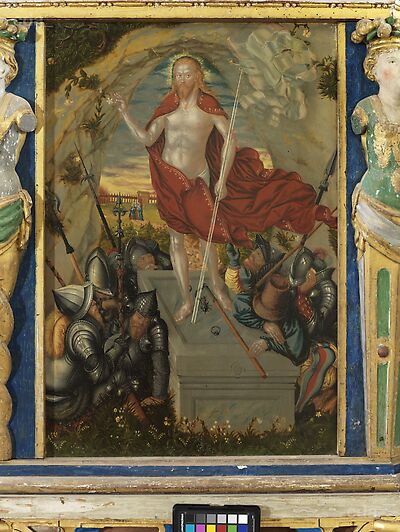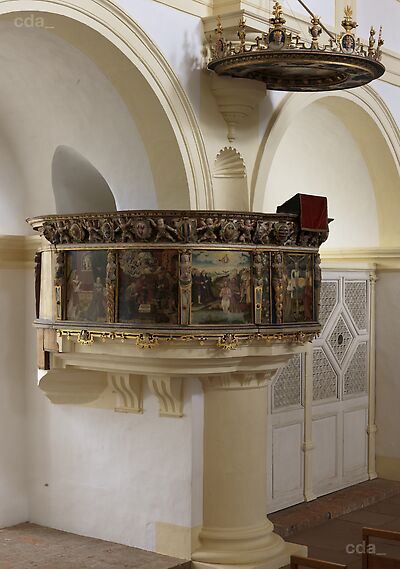Support
The panels are mounted in the pulpit and due to the coniferous wood paneling are not accessible from the reverse, therefore any assessment of the support remains conditional. In the few areas where bare wood is visible it is pale in appearance.
The examination report from 1990 of the conservation of the abat-voix states that its panel painting was executed on lime wood. The support of the altarpiece created by Cranach the Younger for the castle chapel was also lime wood. It may therefore be assumed that the pulpit paintings were also painted on lime wood.
When viewed in raking light a slight unevenness of the surface suggests that the panel consists of three to four planks.
[Herrschaft 2013, 35, 37]
Ground and Imprimatura
A thin glue-chalk ground was applied with a brush to the sized support. On the right and left edges of the panel the ground extends to the edge of the support. The upper edge of the panel appears to have a continuous barb, which is visible on the left half of the panel. It may be assumed that the panel was fixed in plane along at the top and bottom edges by a grooved batten while the ground was applied. There is a thin lead white imprimatura covering the ground.
[Herrschaft 2013, 39]
Underdrawing
The underdrawing on the pulpit paintings was executed on the imprimatura. The lines were carried out in a dry drawing material, possibly a grey/black chalk. The type of underdrawing can be described as sketchy and reduced to the essential lines to describe contours and to define forms. Without elaboration of details and hatching strokes for shadows or volume these underdrawings serve only as a rough orientation for the painted version. During the underdrawing process no clarification from a rough design to a more detailed final underdrawing is apparent. It is hard to image that the painting was completed on the basis of this underdrawing and without reference to a pre-existing design or a prototype.
[Herrschaft 2013, 41]
Paint Layers and Gilding
The paint layers probably consist of pigments bound in oil (a test for protein proved negative). On all the panels the paint layers extend to the edge at the sides - like the ground - whereas the paint layers at the top and bottom end before the ground.
By and large all the panels exhibit a very economic painting technique with a thin application of paint, which nevertheless is predominantly opaque. In addition there are areas of glazed colour, where the imprimatura is occasionally visible and influences the colour scheme of the panel.
The quality of the painting is very mixed and reveals the cooperation of more than one person on each panel. Many of the affectionately executed details are only visible close up, which considering the position of the panels 2 meters above is never possible. Other areas are less precise and occasionally unfinished (this is also the case for the decorative painting on the pulpit).
The painting technique of the sixth panel conforms with that of the other paintings, it is not as subtly nuanced as the Nativity and Baptism scenes, but is very similar to the crucifixion scene.
Jesus' red coat has the same opaque application of paint as the vermilion paint on the other paintings. The folds were also modelled employing dark glazes, which are brown to opaque black. The hem of the coat was finished with a delicate double white line and floral ornamentation. In addition delicate gold lines were applied over the white paint.
The victory banner exhibits dynamic brushstrokes in grey paint applied in a double row. An application of red lake was employed for the background of the banner. Its original luminosity is only preserved at the top edge of the painting. The cross on the banner is almost colourless with the exception of some bluish admixtures in the grey shadows. It is possible that blue organic dyes like indigo or waid were used.
The flesh paint of Christ's corpse corresponds with that of the thieves in the Crucifixion scene. Initially executed in brown, the shadows were modelled in grey and finally a flesh tone was applied in the lighter areas. The painting technique employed for his face is similar to that of St John in the Crucifixion and Entombment scenes with a thickly applied flesh tone over grey shadows on a brown base tone. The cheeks are slightly red. The eyes have black pupils with short black strokes to indicate the eyelids. In contrast the soldiers' faces were executed in a different manner. Dark brown contours were applied to indicate eyes and noses over a brown base tone. Similar to those of the mourning women in the entombment scene - however applied more as a scumble on the soldiers' faces - the faces were covered with grey paint. This flat application was employed in some faces for the highlights only. Beneath this some red is visible on the cheeks. Pure white was only used for the eyeballs. Hair on the heads and beards was - as always - painted with an initial base tone on which the hair was modelled with delicate lines in lighter and darker paint.
To create the metallic appearance of the soldiers' armour black contour lines delineating the various segments were painted on a grey ground and highlights were then added in thick white paint. The chainmail was also initially painted in grey and the links were then added employing short curved strokes of light grey and black paint.
[Herrschaft 2013, 60-62]
